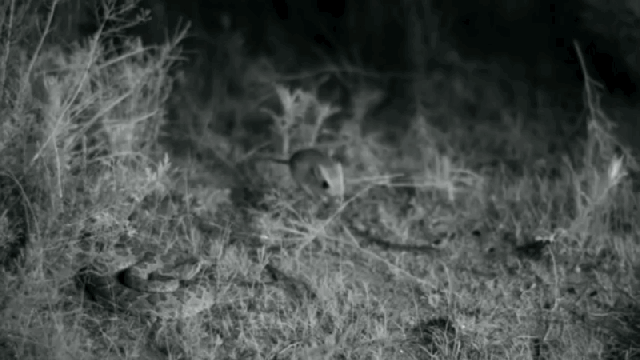Mohave rattlesnakes and Merriam kangaroo rats are currently embroiled in an evolutionary arms race, pitting wily predator against fast-acting prey. Dramatic high-speed video shows how quick and creative snakes need to be to launch an attack — and how rodents still manage to evade capture.
Video: Higham Lab, UC Riverside
Surprisingly, very little is known about rattlesnake attacks. But new technological advances in high-speed cameras are making it possible to capture three-dimensional videos of these lightning-fast strikes in the wild. A team led by University of California-Riverside biologist Timothy Higham used such a setup to film Mohave rattlesnakes in action, allowing them to understand the factors that determine the success or failure of an attack or an escape. Their findings now appear in the latest edition of the journal Science Reports.
According to Higham, the team gathered footage of the rattlesnake strikes under infrared lighting in New Mexico in 2015. “The results are quite interesting in that strikes are very rapid and highly variable,” Higham said in a statement. “The snakes also appear to miss quite dramatically — either because the snake simply misses or the kangaroo rat moves out of the way in time.”
Watching the high-speed video (filmed at 500 frames per second), Higham’s team noticed that the snakes performed better and struck faster in the wild than in laboratory conditions. Horrifyingly, maximum velocities achieved during strikes ranged between 4.2 to 4.8m/s. For an animal that’s crouched motionless in a coil, that’s an insane amount of speed. It’s cool to watch, but for prey animals, that doesn’t leave them much time to react.
Not content to stick with speed as the lone tactic, the snakes were also observed to mix up the style of their attacks. Strikes occurred from a wide swath of distances, ranging from 4.6 to 20cm. When the snakes failed to capture their prey, it was either because the kangaroo rats made an evasive manoeuvre, or because of the snakes’ poor strike accuracy.
The performance of the kangaroo rats was equally impressive — their average response time to an attack was a mere 61.5 milliseconds (by comparison, the average reaction time for humans is about 215 milliseconds). In conjunction with their quick reflexes, the kangaroo rats amplified their jumping power during an attack via something called “elastic energy storage”.
“Elastic energy storage is when the muscle stretches a tendon and then relaxes, allowing the tendon to recoil like an elastic band being released from the stretched position,” Higham explained. “It’s equivalent to a sling shot — you can pull the sling shot slowly and it can be released very quickly. The kangaroo rat is likely using the tendons in its lower leg — similar to our Achilles tendon — to store energy and release it quickly, allowing it to jump quickly and evade the strike.”
Looking ahead, the researchers are hoping to observe other species of rattlesnake and kangaroo rat to explore any differences among the species. Until then, you can marvel — or wince — at the ferocity of these horrifying rattlesnake attacks.
